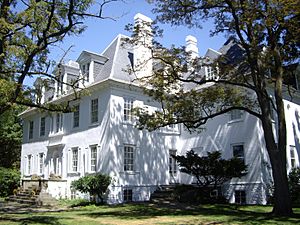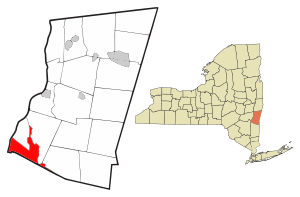Clermont, New York facts for kids
Quick facts for kids
Clermont, New York
|
|
|---|---|

Clermont Manor
|
|

Location of Clermont, New York
|
|
| Country | United States |
| State | New York |
| County | Columbia |
| Government | |
| • Type | Town Council |
| Area | |
| • Total | 19.19 sq mi (49.71 km2) |
| • Land | 18.00 sq mi (46.61 km2) |
| • Water | 1.20 sq mi (3.10 km2) |
| Elevation | 194 ft (59 m) |
| Population
(2020)
|
|
| • Total | 2,058 |
| • Density | 107.24/sq mi (41.400/km2) |
| Time zone | UTC-5 (Eastern (EST)) |
| • Summer (DST) | UTC-4 (EDT) |
| ZIP code |
12526
|
| Area code(s) | 518 |
| FIPS code | 36-021-16177 |
| GNIS feature ID | 0978837 |
Clermont is a small town in Columbia County, New York, United States. The name "Clermont" comes from French and means "Clear Mountain." This name was chosen because of the beautiful mountain views in the area.
In 2020, about 2,058 people lived here. The town is located in the southwestern part of Columbia County. It is just south of the city of Hudson.
Contents
Clermont's History
Clermont started as one of the oldest large estates in the mid-Hudson Valley. It was called the Clermont Manor. This manor was set up in 1728. It was originally part of a much larger area known as the Livingston Manor.
A section of this large manor, about 13,000 acres, was given to Robert Livingston. His family later owned huge amounts of land in the Catskill Mountains and Dutchess County.
During the American Revolution, British soldiers traveled up the Hudson River and reached Clermont. They burned down Livingston's home because he was important in the Revolution. But the house was rebuilt between 1779 and 1782. Today, this house is a New York State Historic Site and a National Historic Landmark. It covers about 500 acres.
In 1788, Clermont Manor officially became the town of Clermont.
Clermont was also important for early steamboats. Robert Fulton's first steamboat, called the North River (now known as the Clermont), was registered here. Its owner, Livingston, helped with the project. You can still find the old dock ruins on the Hudson River at the historic site.
The Livingston family lived in the estate and later the town for seven generations. They lived there until 1962.
Many historic buildings in Clermont are listed on the National Register of Historic Places. These include the Bouwerie, Thomas Brodhead House, Clarkson Chapel, Clermont Academy, Clermont Civic Historic District, Coons House, Hickory Hill, Old Parsonagee, Sixteen Mile District, and St. Luke's Church.
Where is Clermont?
Clermont covers a total area of about 49.7 square kilometers (19.19 square miles). Most of this is land, about 46.6 square kilometers (18.00 square miles). The rest, about 3.1 square kilometers (1.20 square miles), is water.
The southern border of Clermont is also the border of Dutchess County. Part of the western border is the Hudson River, which separates Clermont from Ulster County.
The northeastern border of the town follows the Roeliff Jansen Kill. This is a small river that flows into the Hudson River. The town's shape is a bit unusual because of how these borders are drawn.
Who Lives in Clermont?
The number of people living in Clermont has changed over the years. Here's a look at the population from past censuses:
| Historical population | |||
|---|---|---|---|
| Census | Pop. | %± | |
| 1820 | 1,164 | — | |
| 1830 | 1,203 | 3.4% | |
| 1840 | 1,231 | 2.3% | |
| 1850 | 1,130 | −8.2% | |
| 1860 | 968 | −14.3% | |
| 1870 | 1,021 | 5.5% | |
| 1880 | 918 | −10.1% | |
| 1890 | 798 | −13.1% | |
| 1900 | 812 | 1.8% | |
| 1910 | 800 | −1.5% | |
| 1920 | 667 | −16.6% | |
| 1930 | 805 | 20.7% | |
| 1940 | 806 | 0.1% | |
| 1950 | 898 | 11.4% | |
| 1960 | 980 | 9.1% | |
| 1970 | 1,120 | 14.3% | |
| 1980 | 1,269 | 13.3% | |
| 1990 | 1,443 | 13.7% | |
| 2000 | 1,732 | 20.0% | |
| 2010 | 1,965 | 13.5% | |
| 2020 | 2,058 | 4.7% | |
| U.S. Decennial Census | |||
According to the census from 2000, there were 1,726 people living in Clermont. There were 593 households, which are groups of people living together. About 36.9% of these households had children under 18 living with them.
The population was spread out by age. About 30.3% of the people were under 18 years old. About 11.8% were 65 years or older. The average age in the town was 36 years.
Most people in Clermont were White (96.58%). There were also African American (1.27%), Native American (0.23%), and Asian (0.35%) residents. About 2.72% of the population identified as Hispanic or Latino.
Places in Clermont
Clermont has several smaller communities and locations within its borders:
- Clermont – This is the main hamlet (a small village) in the northeastern part of the town.
- Clermont State Historic Site – This is a special historic place right on the Hudson River. It includes the original Clermont Manor.
- Cross Hill – A small community in the western part of town, located east of the historic site.
- Elizaville – A hamlet found in the southeastern corner of the town.
- Nevis – Another hamlet located south of the main Clermont hamlet, along Route 9.
- Viewmont – A hamlet on the northern border of the town, just north of Cross Hill.
Images for kids
See also
 In Spanish: Clermont (Nueva York) para niños
In Spanish: Clermont (Nueva York) para niños




